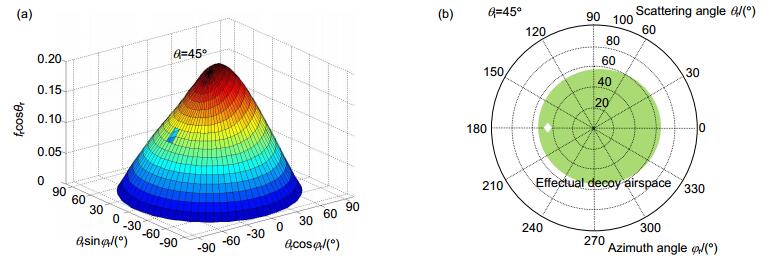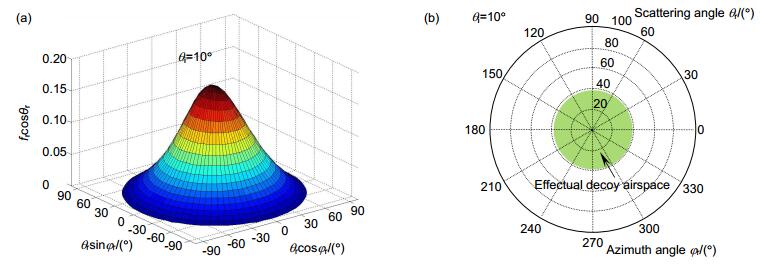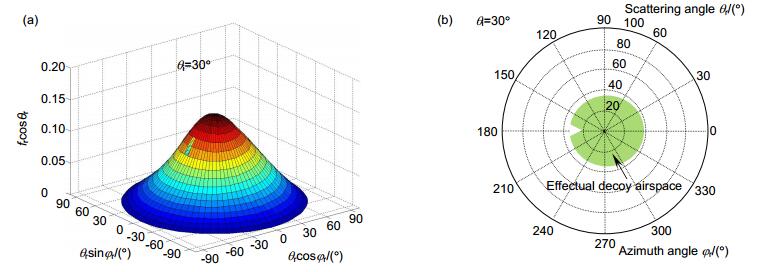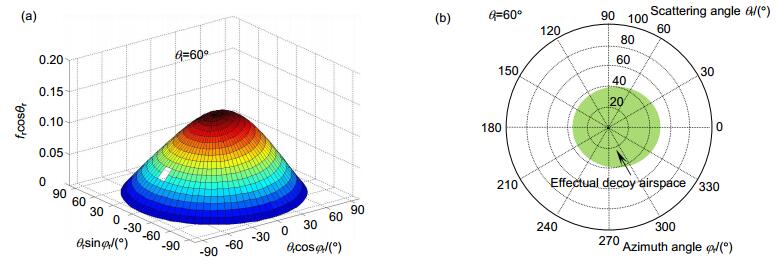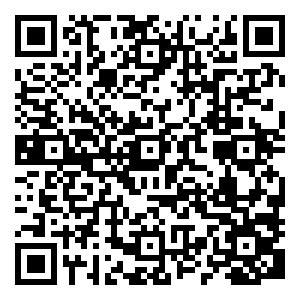Deceiving ability of typical natural objects used for false target in laser decoy jamming
-
摘要
针对自然地物假目标在激光引偏干扰中的应用需求,以有效引偏空域表征引偏能力,计算分析了其引偏能力。在充分考虑目标反射特性、干扰-指示激光强度和大气激光衰减系数等因素的前提下,利用信号压制系数K≥1的条件建立了假目标引偏能力分析模型,基于模型分析了典型条件下常见自然地物假目标的有效引偏空域。研究结果表明,假目标有效引偏空域与目标类型紧密相关,相同条件下植被类、砂石类和漫反射体目标的引偏能力依次增强;植被类和砂石类自然地物的引偏空域存在远小于漫射分量的镜像反射分量;干扰激光入射角的变化对有效引偏空域分布会产生较明显的影响,但对植被类目标,其引偏空域随入射角的变化却没有明显的趋势性变化规律。研究结果对于自然地物假目标的合理运用具有指导意义。

Abstract
Aiming at the application of natural objects false target in laser decoy jamming, its deceiving ability characterized by decoy airspace was calculated and analyzed. On the premise of full considering the reflection characteristics of target, the intensity of jamming-indicating laser, atmospheric laser attenuation coefficient, and other factors, the analysis model of decoy jamming ability for false target was established under the condition of suppression coefficient K (≥1). Furthermore, the effectual decoy airspace of common natural objects was analyzed under typical condition. The results show that the effective cheating airspace of false target is closely related to the type of targets, and the deceiving ability of vegetation, gravel and diffuse reflection objects is enhanced in turn under the same conditions. There exists a mirror reflection component that is much smaller than the diffuse reflection component in the decoy airspace of vegetation and gravel natural objects, and the variation of the incident angle of jamming laser has obvious influence on the distribution of effectual decoy airspace. However, there is no obvious trend change rule for the decoy airspace of vegetation targets with the incidence angle. The research results are instructive for the reasonable application of typical natural objects used for false target.
-
Key words:
- laser decoy jamming /
- false target /
- natural objects /
- decoy airspace /
- suppression coefficient
-
Overview

Overview: Laser decoy jamming is an effective way to combat semi-active laser guided weapons. Diffuse reflecting targets or natural objects are usually used as false targets in laser decoy jamming system. The deceiving ability of the false targets directly determines the layout method and application effect of the false targets. Due to the Lambert reflection characteristics of diffuse reflector target, its deflection ability is easy to be known, while the laser reflection characteristics of natural objects are much more complex. The deflection ability of natural objects is affected by many factors, such as the type of natural object, the parameters of incident laser and the seeker parameters of incoming missile. It is of great significance to study the deflection ability of natural object false target under typical conditions for improving the flexibility of laser decoy jamming system and giving full play to its combat effectiveness. The deceiving ability characterized by effectual decoy airspace of typical natural objects was calculated and analyzed in this paper. Firstly, on the premise of fully considering the target reflection characteristics, jamming-indicating laser intensity, atmospheric laser attenuation coefficient and other factors, the analysis model of false target deflection ability was established under the condition of signal suppression coefficient K (≥1), which was a complex expression related to the bidirectional reflection distribution function of false target and the parameters of application conditions. Then, a five-parameter semi-empirical statistical model based on the Torrance-Sparrow model was selected to describe the bi-directional laser reflection characteristics of typical natural objects. The undetermined parameters in the statistical model were derived from the research results of existing literatures, and the parameters related to the application conditions in the deflection analysis model were based on the general engineering practice. Based on these preconditions, the effective decoy airspace of typical natural object false targets was calculated and the deceiving ability was analyzed. The results show that the effective cheating airspace of false target is closely related to the type of targets, and the deceiving ability of vegetation, gravel and diffuse reflection objects is enhanced in turn under the same conditions. There exists a mirror reflection component that is much smaller than the diffuse reflection component in the decoy airspace of vegetation and gravel natural objects, and for vegetation targets, the variation of the incident angle of jamming laser has obvious influence on the distribution of effectual decoy airspace. However, there is no obvious trend change rule of the decoy airspace with the incidence angle. The research results are instructive for the reasonable application of typical natural objects used as false target.
-

-
表 1 五参数半经验统计模型待定系数的选取
Table 1. Selection of undetermined coefficients for five parameters semi-empirical statistical model
目标类型 kb kr kd a b 植被类 0.1263 0.3002 0.04840 1.133 -10.52 砂石类 0.1565 0.2930 0.1054 1.453 -37.52 -
参考文献
[1] 吕跃广, 孙晓泉.激光对抗原理与应用[M].北京:国防工业出版社, 2015: 185-186.
Lv Y G, Sun X Q. Fundamentals and Applications of Laser Countermeasures[M]. Beijing: National Defense Industry Press, 2015: 185-186.
[2] 陈蔚, 龚赤坤, 陆君, 等.激光角度欺骗干扰设备对自然地物激光假目标的设置[J].红外与激光工程, 2012, 41(2): 452-456. doi: 10.3969/j.issn.1007-2276.2012.02.033
Chen W, Gong C K, Lu J, et al. Selection of laser angle deceptive interference to natural objects[J]. Infrared and Laser Engineering, 2012, 41(2): 452-456. doi: 10.3969/j.issn.1007-2276.2012.02.033
[3] 仝力鹏, 宋德安.激光角度欺骗干扰中的自然地物假目标区域选择研究[J].中国人民解放军电子工程学院学报, 2011, 30(2): 50-53.
Tong L P, Song D A. Research on selection of areas where natural objects serving as decoys in laser angle deception jamming[J]. Journal of PLA Electronic Engineering Institute, 2011, 30(2): 50-53.
[4] 孙春生, 张晓晖, 饶炯辉, 等.激光引偏干扰中漫反射板假目标的布设方法[J].激光与红外, 2013, 43(3): 252-255. doi: 10.3969/j.issn.1001-5078.2013.03.005
Sun C S, Zhang X H, Rao J H, et al. Layout of diffuse reflection board used for laser decoying[J]. Laser & Infrared, 2013, 43(3): 252-255. doi: 10.3969/j.issn.1001-5078.2013.03.005
[5] 孙春生, 张晓晖, 张爽.激光引偏干扰中假目标的防护角与应用[J].激光与红外, 2017, 47(3): 347-351. doi: 10.3969/j.issn.1001-5078.2017.03.018
Sun C S, Zhang X H, Zhang S. Guarded angle of laser decoy in laser trick jamming[J]. Laser & Infrared, 2017, 47(3): 347-351. doi: 10.3969/j.issn.1001-5078.2017.03.018
[6] Feidenhans'l N A, Hansen P E, Pilný L, et al. Comparison of optical methods for surface roughness characterization[J]. Measurement Science and Technology, 2015, 26: 085208. doi: 10.1088/0957-0233/26/8/085208
[7] Wen J G, Liu Q, Xiao Q, et al. Characterizing land surface anisotropic reflectance over rugged terrain: a review of concepts and recent developments[J]. Remote Sensing, 2018, 10(3): 370. doi: 10.3390/rs10030370
[8] Sun Z Q, Wu D, Zhao Y S. Improved kernel-driven semi-empirical bidirectional reflectance factor models for characterizing the reflection of vegetation covers: considering a specular kernel[J]. Agricultural and Forest Meteorology, 2018, 260-261: 95-108. doi: 10.1016/j.agrformet.2018.06.005
[9] 吴振森, 谢东辉, 谢品华, 等.粗糙表面激光散射统计建模的遗传算法[J].光学学报, 2002, 22(8): 897-901. doi: 10.3321/j.issn:0253-2239.2002.08.001
Wu Z S, Xie D H, Xie P H, et al. Modeling reflectance function from rough surface and algorithms[J]. Acta Optica Sinica, 2002, 22(8): 897-901. doi: 10.3321/j.issn:0253-2239.2002.08.001
[10] Torrance K E, Sparrow E M. Theory for off-specular reflection from roughened surfaces[J]. Journal of the Optical Society of America, 1967, 57(9): 1105-1114. doi: 10.1364/JOSA.57.001105
[11] 杨玉峰, 吴振森, 曹运华.一种实用型粗糙面六参数双向反射分布函数模型[J].光学学报, 2012, 32(2): 0229001. http://www.wanfangdata.com.cn/details/detail.do?_type=perio&id=QK201200361433
Yang Y F, Wu Z S, Cao Y H. Practical six-parameter bidirectional reflectance distribution function model for rough surface[J]. Acta Optica Sinica, 2012, 32(2): 0229001. http://www.wanfangdata.com.cn/details/detail.do?_type=perio&id=QK201200361433
[12] 陈玉丹, 张维安, 陈玉成, 等.多类目标样片激光散射特性研究[J].应用光学, 2011, 32(6): 1251-1256. http://d.old.wanfangdata.com.cn/Periodical/yygx201106038
Chen Y D, Zhang W A, Chen Y C, et al. Laser scattering characteristic of several object samples[J]. Journal of Applied Optics, 2011, 32(6): 1251-1256. http://d.old.wanfangdata.com.cn/Periodical/yygx201106038
[13] 王安祥, 吴振森.光散射模型中遮蔽函数的参数反演[J].红外与激光工程, 2014, 43(1): 332-337. doi: 10.3969/j.issn.1007-2276.2014.01.059
Wang A X, Wu Z S. Parameter inversion of shadowing function in light scattering model[J]. Infrared and Laser Engineering, 2014, 43(1): 332-337. doi: 10.3969/j.issn.1007-2276.2014.01.059
-
访问统计


 E-mail Alert
E-mail Alert RSS
RSS
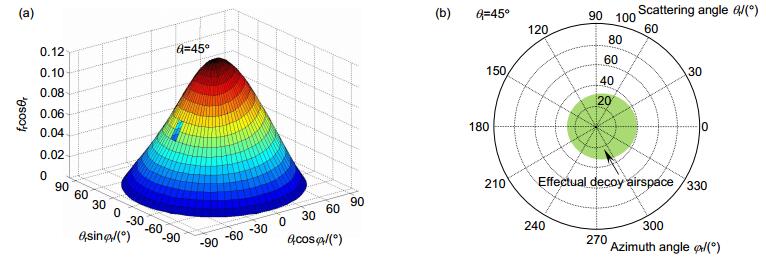
 下载:
下载:
